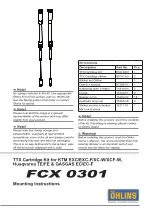
Page
151
of
254
Version 6.3
Rev
r012
Date
05-11-2022
5.
Secure the bitter end of the downline to the vessel.
6.
Request permission, from the bridge or helm, to deploy and await their OK to launch.
a.
Bridge or helm to ensure that the vessel is out of traffic.
b.
Bridge or helm to assess wind and sea conditions and advise as to which side of the
vessel the deployment should be made.
7.
Put the probe in the water until it is totally covered and let it remain there for a period of
time to acclimate to the sea temperature. This is very important with a CTD type of probe,
but of less concern for a time-of-flight probe.
8.
Verify the water depth.
9.
Lower the probe at a constant rate; only the downcast should be used.
10.
Try not to allow the probe to touch the bottom.
11.
Recover the probe rapidly.
12.
As soon as the probe is on deck, notify the bridge or helm that they are free to manoeuvre,
but remain in the area.
13.
Rinse the probe with fresh water and dry thoroughly.
14.
Download the cast and verify that it looks good.
15.
Load the cast into the data collection software.
8.6.5.2
Deep Water Cast / Deployment by mechanical means
A cast in deeper water requires more preparation and planning. A deepwater cast can be
considered to be any cast that is deployed via an ‘A’ Frame, winch, or other mechanical means.
Even a shallow water cast can fall under this definition when mechanical means are used.
One of the main concerns, in a deep water cast, is that the probe will not go straight down due to
the current flow or vessel drift due to wind and/or currents. This being the case, weights must be
used to ensure the cable (and probe) go as straight down as possible.
Unless the sound velocity probe is designed to have an additional weight attached to it, no weights
should be attached to the sound velocity probe. The weights, which enable deployment as straight
as possible, are attached to the end of the cable. The probe should be attached to the cable
approximately 3 – 5 metres above the weights; if the weights hit bottom, this should provide
enough scope for the probe to land clear of the weights.
Summary of Contents for 2026
Page 2: ...Page 2 of 254 Version 6 3 Rev r012 Date 05 11 2022 Part No 96000001...
Page 14: ...Page 14 of 254 Version 6 3 Rev r012 Date 05 11 2022 Part No 96000001...
Page 22: ...Page 22 of 254 Version 6 3 Rev r012 Date 05 11 2022 Part No 96000001...
Page 28: ...Page 28 of 254 Version 6 3 Rev r012 Date 05 11 2022 Part No 96000001...
Page 32: ...Page 32 of 254 Version 6 3 Rev r012 Date 05 11 2022 Part No 96000001...
Page 48: ...Page 48 of 254 Version 6 3 Rev r012 Date 05 11 2022 Part No 96000001...
Page 56: ...Page 56 of 254 Version 6 3 Rev r012 Date 05 11 2022 Part No 96000001...
Page 116: ...Page 116 of 254 Version 6 3 Rev r012 Date 05 11 2022 Part No 96000001...
Page 120: ...Page 120 of 254 Version 6 3 Rev r012 Date 05 11 2022 Part No 96000001...
Page 122: ...Page 122 of 254 Version 6 3 Rev r012 Date 05 11 2022 Part No 96000001...
Page 131: ...Page 131 of 254 Version 6 3 Rev r012 Date 05 11 2022...
Page 138: ...Page 138 of 254 Version 6 3 Rev r012 Date 05 11 2022 Part No 96000001...
Page 158: ...Figure 174 Smooth log information copied from a real time survey log...
Page 182: ...Page 182 of 254 Version 6 3 Rev r012 Date 05 11 2022 Part No 96000001...
Page 198: ...Page 198 of 254 Version 6 3 Rev r012 Date 05 11 2022 Part No 96000001...
Page 210: ...Page 210 of 254 Version 6 3 Rev r012 Date 05 11 2022 Part No 96000001...
Page 234: ...Page 234 of 254 Version 6 3 Rev r012 Date 05 11 2022 Part No 96000001...
Page 237: ...Page 237 of 254 Version 6 3 Rev r012 Date 05 11 2022 Figure 215 Sonic 2026 Projector...
Page 247: ...Page 247 of 254 Version 6 3 Rev r012 Date 05 11 2022 Figure 225 SIM Stack Outline...
Page 249: ...Page 249 of 254 Version 6 3 Rev r012 Date 05 11 2022 Figure 227 Locking Ring type Deck Lead...
Page 251: ...Page 251 of 254 Version 6 3 Rev r012 Date 05 11 2022 Figure 229 I2NS Type 82 IMU offsets...
Page 253: ...Page 253 of 254 Version 6 3 Rev r012 Date 05 11 2022 Figure 231 I2NS SIM Dimensions...
















































